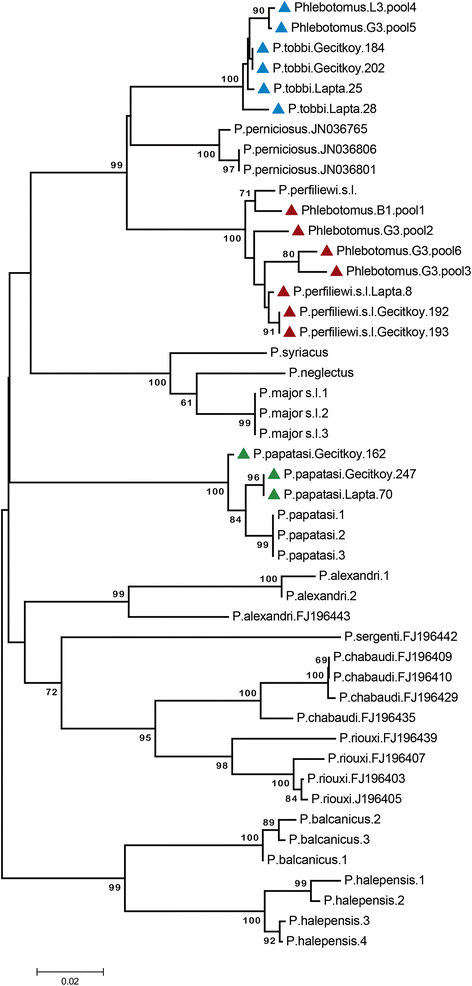Phlebovirus and Leishmania detection in sandflies from eastern Thrace and northern Cyprus
- PMID: 25499083
- PMCID: PMC4269954
- DOI: 10.1186/s13071-014-0575-6
Phlebovirus and Leishmania detection in sandflies from eastern Thrace and northern Cyprus
Abstract
Background: Phlebotomine sandflies are vectors of several pathogens with significant impact for public health. This study was conducted to investigate and characterize phlebovirus and Leishmania infections in vector sandflies collected in the eastern Thrace region in Turkey and Northern Cyprus, where previous data indicate activity of these agents.
Methods: Field sampling of sandflies was performed at 4 locations in Edirne and Tekirdag provinces of eastern Thrace and at 17 locations in Lefkosa, Girne, Magosa and Guzelyurt provinces of northern Cyprus. In sandfly pools, phlebovirus RNA and Leishmania DNA were screened via a generic polymerase chain reaction (PCR) and kinetoplast minicircle PCR, respectively. Selected sandfly specimens unsuitable for pathogen detection were identified to species level. Cytochrome oxidase 1 gene region was used for DNA barcoding of selected specimens and pathogen positive pools. Positive amplicons were cloned and characterized by sequencing.
Results: A total of 2690 sandflies, collected from Eastern Thrace (15.4%) and Northern Cyprus (84.6%) were evaluated. Morphological examination of 780 specimens from Cyprus exhibited Phlebotomus perfiliewi sensu lato (72.6%), Phlebotomus tobbi (19.7%), Phlebotomus papatasi (2.8%), Laroussius sp. (1.6%) and Sergentomyia azizi (1.6%), Sergentomyia sp. (0.9%), Sergentomyia minuta (0.5%) and Phleobotomus jacusieli (0.1%) species. Pathogen screening was performed in 1910 specimens distributed in 195 pools. In eight pools of P.tobbi sandflies collected in Cyprus, Leishmania infantum DNA was demonstrated. Toscana virus (TOSV) genotype A sequences were identified in two pools of P. perfiliewi s.l. and one pool of P.tobbi sandflies from Cyprus. Co-infection of TOSV and Leishmania infantum was characterized in a P.tobbi pool. Sequences belonging to novel phleboviruses are revealed in three P. perfiliewi s.l. pools. One sequence, provisionally named Edirne virus, identified in Edirne province in eastern Thrace, demonstrated the highest rate of genomic similarity to Adria and Salehabad viruses. Furthermore, Girne 1 and Girne 2 viruses, identified in Girne province, revealed similarities to TOSV and Sandfly Fever Sicilian virus and related strains, respectively.
Conclusions: Activity of TOSV genotype A strains in Cyprus and co-infection of sandfly vectors with L. infantum was documented for the first time. Novel phlebovirus strains of unknown medical significance was identified in sampling regions.
Figures



References
-
- Depaquit J, Grandadam M, Fouque F, Andry PE, Peyrefitte C. Arthropod-borne viruses transmitted by Phlebotomine sandflies in Europe: a review. Euro Surveill. 2010;15:19507. - PubMed
-
- Plyusnin A, Beaty BJ, Elliott RM, Goldbach R, Kormelink R, Lundkvist A, Schmaljohn CS, Tesh RB. Bunyaviridae. In: King AMQ, Adams MJ, Carstens EB, Lefkowitz EJ, editors. Ninth Report of the International Committee on Taxonomy of Viruses. San Diego: Elsevier Academic Press; 2012. pp. 725–741.
Publication types
MeSH terms
LinkOut - more resources
Full Text Sources
Other Literature Sources
Molecular Biology Databases

